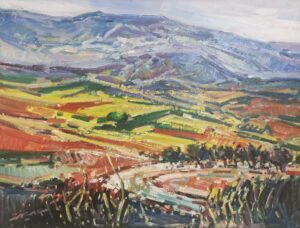
Español
José Cózar Viedma est né à Baeza le 6 juin 1944.
Sa formation académique, avec une prédisposition innée au dessin, au pinceau dans sa jeunesse et au couteau par la suite, a toujours poursuivi le un chemin esthétique et aujourd’hui on peut dire qu’il est un maître sur la terre des artistes, Valence, ville dans laquelle il réside depuis 1955, bien que son séjour à Baeza soit très fréquent durant l’année.Le peintre baezano a obtenu sa première reconnaissance officielle à 19 ans avec le Premier Prix de la XIXe Exposition Nationale de Linares et, dès lors, se succèdent les prix, reconnaissances et hommages au cours de sa longue carrière artistique. Le nombre d’œuvres réalisées est incalculable, atteignant jusqu’à 200 tableaux par an au stade de maturité.
Sa peinture est aussi trépidante que spontanée, aussi sincère que pénétrante, ses œuvres peuvent être contemplées dans les musées, députations, mairies ou universités tels que le Conseil Général de Barcelone, Musée Historique Municipal de Valence, Musée municipal de Segorbe, Musée Ethnographique de Jávea, Mairies de Jaén, Villajoyosa et Baeza….
Quelques livres édités sur son œuvre sont “La vie et l’œuvre de Cózar”, par Manuel Real Alarcón, “Cózar” par Marien Rovalo et “Cent ans après… Le fauvisme dans la peinture de Cózar” par Lorenzo Berenguer et Beatriz Vázquez.
Comme nous l’avons mentionné précédemment, nombreuses sont les distinctions qui jalonnent sa vie professionnelle, parmi lesquelles il convient de mentionner le Vítor de Arte de l’Association culturelle Baezana, Frère Majeur de la Confrérie du Saint-Christ Veracruz de Baeza.